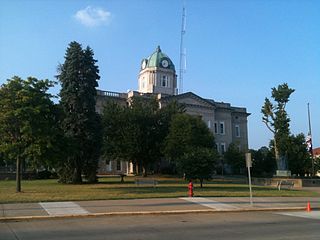
Jackson is a city in and the county seat of Cape Girardeau County, Missouri, United States. It is a principal city of the Cape Girardeau–Jackson, MO-IL Metropolitan Statistical Area. The population of Jackson was 15,481 at the 2020 census.

Cape Girardeau is a city in Cape Girardeau and Scott Counties in the U.S. state of Missouri. At the 2020 census, the population was 39,540. The city is the economic center of rural Southeast Missouri and also an emerging college town as the home of Southeast Missouri State University. It is located approximately 100 miles (161 km) southeast of St. Louis and 150 miles (241 km) north of Memphis.
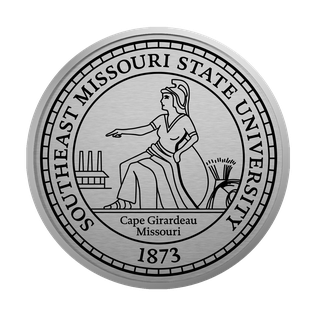
Southeast Missouri State University is a public university in Cape Girardeau, Missouri. In addition to the main campus, the university has four regional campuses offering full degree programs and a secondary campus housing the Holland College of Arts and Media. The university is accredited by the Higher Learning Commission.
The Second Battle of Springfield was a battle in the American Civil War fought January 8, 1863, in Springfield, Missouri. It is sometimes known as The Battle of Springfield. Fighting was urban and house-to-house, which was rare in the war.
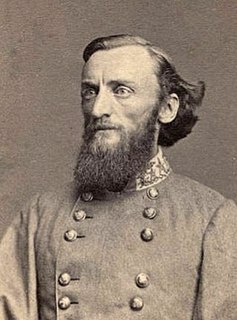
John Sappington Marmaduke was an American politician and soldier. He served as the 25th governor of Missouri from 1885 until his death in 1887. During the American Civil War, he was a senior officer of the Confederate States Army who commanded cavalry in the Trans-Mississippi Theater.

Shelby's Raid was an 1863 Confederate cavalry raid from Arkansas into Missouri during the American Civil War. It had not been a good year for the Confederates in Arkansas, with several setbacks. These included the loss of the state capital and Fort Hindman, and the failure to retake Helena. Colonel Joseph Shelby thought that a fast moving raid could boost morale, acquire recruits, and keep federal troops busy so they couldn't assist in Northern operations elsewhere. His troops fought numerous skirmishes and caused a deal of disruption in Missouri, making it as far north as Waverly, Missouri, before withdrawing to Arkansas. This raid cemented Shelby's reputation as a cavalry commander and made plain that Missouri was still vulnerable to this kind of cavalry raid.
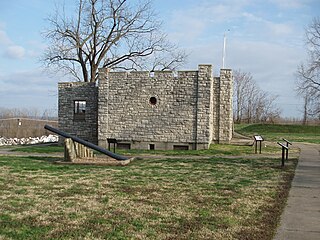
Fort D is a Civil War-era fort alongside the Mississippi River in Cape Girardeau, Missouri, USA.

The Southeast Missourian is a 3 day per week newspaper published in Cape Girardeau, Missouri, and serves the southeastern portion of Missouri.
Rust Communications is an American privately owned media company based in Cape Girardeau, Missouri. The Southeast Missourian is its flagship publication.
Franklin Cannon was an American politician from the state of Missouri. A Democrat, he served as the state's 5th Lieutenant Governor. Cannon was the son-in-law of Missouri's 3rd Governor, Daniel Dunklin.

A special election for Missouri's 8th congressional district was held on June 4, 2013, following the resignation of Jo Ann Emerson on January 22, 2013, to head the National Rural Electric Cooperative Association. The Republican and Democratic parties selected their own nominees without a primary.
The Brown's Arkansas Artillery Battery (1862–1863) was a Confederate Army artillery battery during the American Civil War. Also known as: the Newton Artillery. The battery operated in the Confederate Department of the Trans-Mississippi for its entire existence.
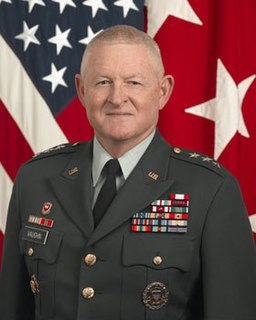
Clyde A. Vaughn is a retired United States Army Lieutenant General who served as Director of the Army National Guard.

Frank Paul Pellegrino was an American businessman. He was the longest-serving chairman and CEO of the International Hat Company. Pellegrino built numerous factories across Southeastern Missouri, managing the company into becoming the largest manufacturing employer in the region by the 1960s.

Maria Pellegrino Park is a municipal park in the western of portion of Marble Hill, Missouri. The park is the largest of the five reserves in the municipality. Pellegrino Park features tennis courts, pavilions, playground equipment, picnic tables, restroom facilities, forest, and a two acre lake for fishing. The park began planning in 1969 and was established in 1972 on 31 acres of city owned land. The park was founded by Frank Pellegrino, the former president and chairman of the International Hat Company of St. Louis. The company operated one of its factories in Marble Hill until 1989, employing approximately 300 people. The park was built on land donated by the company located directly adjacent to International Hat's manufacturing plant. Pellegrino named the park in honor of his Italian-American mother, Maria Pellegrino. The plaque located at the entrance gate reads that the park is dedicated to her "as an expression of her concern for the betterment of her fellowman."

The 6th Missouri Infantry was an infantry regiment of the Confederate States Army during the American Civil War. The regiment was formed on August 26, 1862, when two existing units were combined. Later that year, the regiment was then lightly engaged at the Battle of Iuka and saw heavy action at the Second Battle of Corinth. In 1863, the regiment was engaged at the Battle of Port Gibson, and was part of a major charge at the Battle of Champion Hill. After a defeat at the Battle of Big Black River Bridge, the regiment took part in the siege of Vicksburg, where it saw heavy fighting. The siege of Vicksburg ended on July 4 with a Confederate surrender; after being exchanged, the regiment combined with the 2nd Missouri Infantry to form the 2nd and 6th Missouri Infantry (Consolidated). The 6th Missouri Infantry ceased to exist as a separate unit.
The 13th Missouri Cavalry Regiment was a cavalry unit that served in the Confederate States Army during the American Civil War. In early April 1863, Captain Robert C. Wood, aide-de-camp to Confederate Major General Sterling Price, was detached to form an artillery unit from some of the men of Price's escort. Wood continued recruiting for the unit, which was armed with four Williams guns, and grew to 275 men by the end of September. The next month, the unit fought in the Battle of Pine Bluff, driving back Union Army troops into a barricaded defensive position, from which the Union soldiers could not be dislodged. By November, the unit, which was known as Wood's Missouri Cavalry Battalion, had grown to 400 men but no longer had the Williams guns. In April 1864, Wood's battalion, which was also known as the 14th Missouri Cavalry Battalion, played a minor role in the defeat of a Union foraging party in the Battle of Poison Spring, before spending the summer of 1864 at Princeton, Arkansas. In September, the unit joined Price's Raid into the state of Missouri, but their assault during the Battle of Pilot Knob failed to capture Fort Davidson.
The 10th Texas Field Battery was an artillery battery that served in the Confederate States Army during the American Civil War. After being formed in early 1861 by Benjamin H. Pratt, the battery served with a cavalry formation led by Colonel William Henry Parsons for part of 1862. It was called upon to enter Missouri in support of troop movements related to the Battle of Prairie Grove, but this did not occur. It then operated along the Mississippi River in early 1863, harassing enemy shipping. The unit then participated in Marmaduke's Second Expedition into Missouri and the Battle of Pine Bluff in 1863. Late in 1864, the battery, now under the command of H. C. Hynson, served in Price's Raid, participating in several battles and skirmishes, including the disastrous Battle of Mine Creek. One source claims the unit's service ended on May 26, 1865, while a Confederate report dated June 1, 1865, states that it existed but did not have cannons. Confederate forces in the Trans-Mississippi Department surrendered on June 2.
















